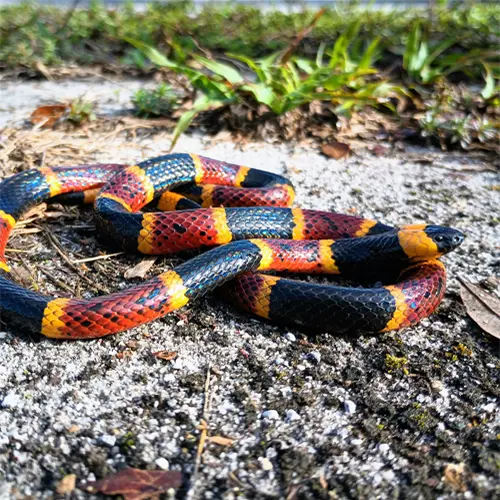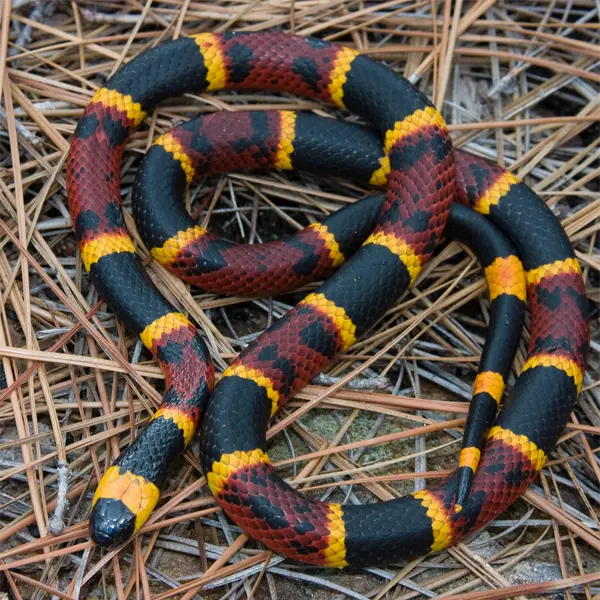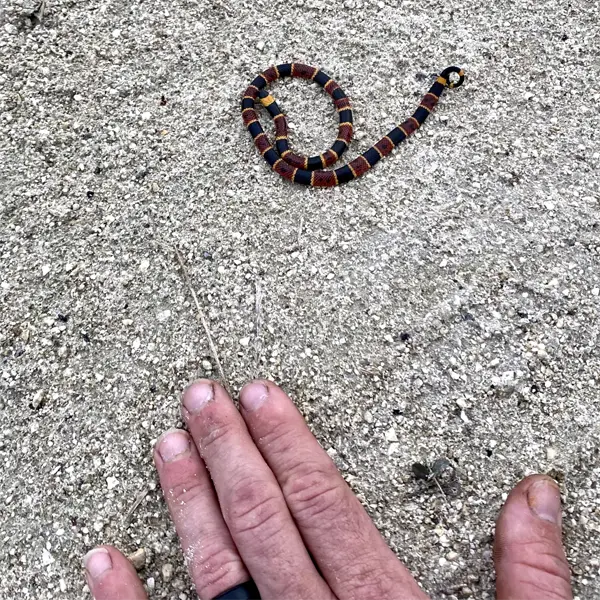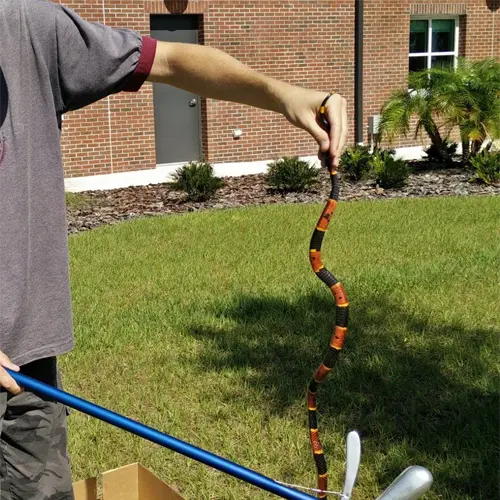The Eastern Coral Snake in Central Florida
The Eastern Coral Snake (Micrurus fulvius), also known as the Harlequin Coralsnake is a highly venomous elapid species found in the southeastern United States, including the central Florida region. This beautiful but dangerous snake can be identified by its distinct red, yellow and black banded pattern.
Learning to recognize coral snakes and giving them distance is crucial to avoid envenomation, as their neurotoxic venom can paralyze and kill humans. This guide covers identification tips, biology, habitat, diet, health risks, and prevention methods for the eastern coral snake in central Florida.
Appearance and Identification
The eastern coral snake can be distinguished from look-alike species by the following characteristics
The coral snake’s distinctive color pattern distinguishes it from mimics like the Scarlet Kingsnake which has adjacent red and black bands. Coral snakes also lack the rattles and elliptical pupils characteristic of venomous vipers in Florida. Proper identification is crucial before considering approach or handling.
Maturation Rate
Young coral snakes grow rapidly, gaining about 5 inches per year until reaching adult size after 2-3 years. Sexual maturity occurs at around 2 years old. At birth, they are fully venomous and capable of subduing prey. Their venom apparatuses and skills are innate, not learned.
Habits and Behavior
Coral snakes spend much of their time underground or sheltered in leaf litter. They are mainly nocturnal or crepuscular, emerging at night to hunt small prey. When above ground, they are slow and deliberate, relying on cryptic coloration for camouflage. If threatened, they may burrow into loose soil or leaf litter to escape.
Coral snakes are not aggressive and their fangs are relatively small, requiring chewing action to deliver venom. Bites often result in little or no venom injected. Due to their reclusive nature, coral snake bites are infrequent compared to other venomous snake species. Their potent neurotoxic venom is a greater danger than their behavior.
Reproduction and Lifespan
Mating occurs in spring, with ovulation delayed until late summer or fall. Females lay 2-10 eggs in burrows or under logs and litter, tending them until hatching in early fall. Hatchlings are 6-8 inches long and highly venomous.
Coral snakes may live up to 8 years in the wild. Their reclusive nature makes observation challenging. They spend much time sheltered underground, only emerging for brief periods to mate and hunt. This secretive lifestyle contributes to their longevity.
Ideal Habitat and Range
The warm, humid climate of central Florida provides ideal habitat for the eastern coral snake year round. Average temperatures range from the 60s°F (15-20°C) in winter to over 80°F (27°C) in summer. Rainfall averages 50+ inches annually, with peak precipitation in June through September.
This subtropical environment supports dense vegetation like palmetto scrub, pine flatwoods, swamps, and hammocks. Leaf litter, decaying logs, and loose sandy soils provide ample shelter. The abundance of small reptiles, amphibians, and rodents also supplies coral snakes with prey.
Developed areas adjacent to wildlands like parks and nature preserves harbor coral snake populations close to human habitation. Range expansion is occurring as this habitat generalist adapts to disturbed areas. Climate change may also enable coral snakes to expand northward.
Diet and Feeding
Coral snakes primarily prey on smaller reptiles and amphibians which are permanently paralyzed by their potent neurotoxic venom. Prey includes:
- Lizards – skinks, anoles, geckos
- Small snakes – ringneck snakes, worm snakes, baby pygmy rattlesnakes
- Frogs, toads, salamanders
- Caecilians
- Small mammals – shrews, moles, mice
They subdue prey by biting and holding on until the venom takes effect. Coral snakes then swallow prey whole, enabled by their expandable jaws. They feed infrequently, only needing to eat every 2-4 weeks.
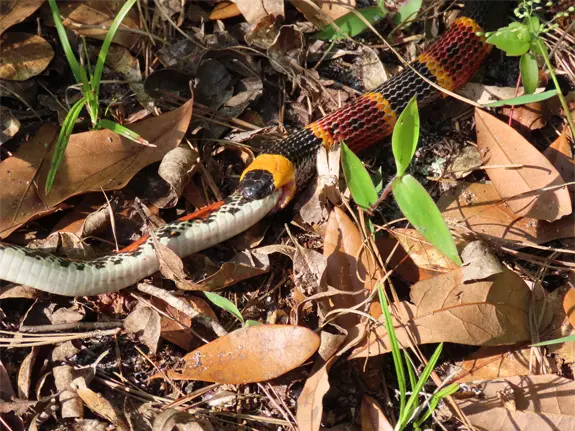
Photo 264162428 © Richard D Reams, CC BY-NC

Common Health Risks
The coral snake’s venom contains powerful neurotoxins that paralyze nerves and breathing. Bites can be fatal if the venom spreads through the body before antivenom is administered. Symptoms include:
- Local pain, swelling, numbness at bite site
- Nausea, vomiting, excessive salivation
- Blurred vision, drooping eyelids
- Muscle paralysis
- Respiratory failure
- Unconsciousness and death in severe untreated cases
If bitten, remain calm and still to slow venom spread. Seek immediate medical care – antivenom can prevent severe effects if given promptly. Fatalities are unlikely if treated, but coral snake venom is highly dangerous and should always be avoided.
Preventing Coral Snake Encounters
Coral snakes are not aggressive toward humans and bites are rare provided distance is given. To avoid incidents:
- Wear durable shoes and gloves while gardening in coral snake habitat.
- Avoid putting hands in areas where visibility is obscured. Inspect logs, debris piles, etc. before reaching in crevices.
- Supervise children and pets outdoors as coral snakes may shelter in yards. Teach them to recognize and steer clear of coral snakes.
- Call a professional if a coral snake is spotted repeatedly near your home. They can safely remove and relocate it.
- Leave snakes alone if encountered and back away slowly. Never try to kill or handle, even if presumed dead.
Eastern Coral Snakes in Central Florida – Conclusion
The eastern coral snake is a shy, reclusive native species that plays an important role controlling rodents and small reptiles in Florida’s ecosystems. With proper identification and safe distance, incidents are readily prevented, even as development brings humans into closer contact.
Awareness and appreciation for this unique snake can help avoid persecution and promote peaceful coexistence.

